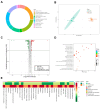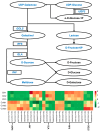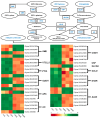Multi-Omics Analysis Provides Insights into Green Soybean in Response to Cold Stress
- PMID: 39728468
- PMCID: PMC11678371
- DOI: 10.3390/metabo14120687
Multi-Omics Analysis Provides Insights into Green Soybean in Response to Cold Stress
Abstract
Green soybean (Glycine max (L.) Merrill) is a highly nutritious food that is a good source of protein and fiber. However, it is sensitive to low temperatures during the growing season, and enhancing cold tolerance has become a research hotspot for breeding improvement. Background/Objectives: The underlying molecular mechanisms of cold tolerance in green soybean are not well understood. Methods: Here, a comprehensive analysis of transcriptome and metabolome was performed on a cold-tolerant cultivar treated at 10 °C for 24 h. Results: Compared to control groups, we identified 17,011 differentially expressed genes (DEGs) and 129 differentially expressed metabolites (DEMs). The DEGs and DEMs were further subjected to KEGG functional analysis. Finally, 11 metabolites (such as sucrose, lactose, melibiose, and dehydroascorbate) and 17 genes (such as GOLS, GLA, UGDH, and ALDH) were selected as candidates associated with cold tolerance. Notably, the identified metabolites and genes were enriched in two common pathways: 'galactose metabolism' and 'ascorbate and aldarate metabolism'. Conclusions: The findings suggest that green soybean modulates the galactose metabolism and ascorbate and aldarate metabolism pathways to cope with cold stress. This study contributes to a deeper understanding of the complex molecular mechanisms enabling green soybeans to better avoid low-temperature damage.
Keywords: colds stress; green soybean (Glycine max (L.) Merrill); metabolome; molecular mechanism; transcriptome.
Conflict of interest statement
The authors declare that this research was conducted in the absence of any commercial or financial relationships that could be construed as potential conflicts of interest.
Figures




Similar articles
-
Integrating Physiology, Transcriptome, and Metabolome Analyses Reveals the Drought Response in Two Quinoa Cultivars with Contrasting Drought Tolerance.Int J Mol Sci. 2024 Nov 13;25(22):12188. doi: 10.3390/ijms252212188. Int J Mol Sci. 2024. PMID: 39596254 Free PMC article.
-
Combined metabolome and transcriptome analysis reveals the key pathways involved in the responses of soybean plants to high Se stress.Ecotoxicol Environ Saf. 2024 Nov 15;287:117262. doi: 10.1016/j.ecoenv.2024.117262. Epub 2024 Oct 30. Ecotoxicol Environ Saf. 2024. PMID: 39476650
-
Integrative analysis of metabolome and transcriptome reveals the improvements of seed quality in vegetable soybean (Glycine max (L.) Merr.).Phytochemistry. 2022 Aug;200:113216. doi: 10.1016/j.phytochem.2022.113216. Epub 2022 Apr 27. Phytochemistry. 2022. PMID: 35487251
-
Full-length transcriptome profiling reveals insight into the cold response of two kiwifruit genotypes (A. arguta) with contrasting freezing tolerances.BMC Plant Biol. 2021 Aug 11;21(1):365. doi: 10.1186/s12870-021-03152-w. BMC Plant Biol. 2021. PMID: 34380415 Free PMC article.
-
Transcriptomic and Metabolomic Analyses Reveal the Key Genes Related to Shade Tolerance in Soybean.Int J Mol Sci. 2023 Sep 18;24(18):14230. doi: 10.3390/ijms241814230. Int J Mol Sci. 2023. PMID: 37762532 Free PMC article.
References
Grants and funding
LinkOut - more resources
Full Text Sources

